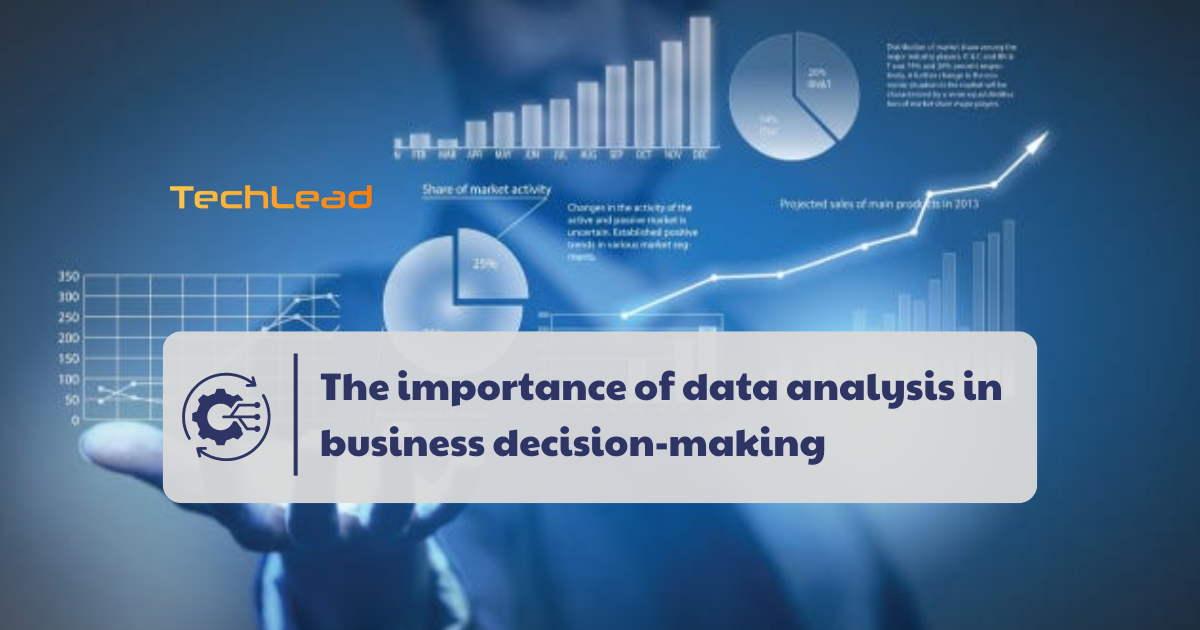In today’s business landscape, data analysis is vital for decision-making and strategic planning. This blog explores data analysis’s importance in business decisions.
Information about Data Analysis – Things You Might Not Know
1. Definition of Data Analysis
Data analysis refers to the process of systematically applying statistical and logical techniques to describe, illustrate, condense, and recap data. It involves various procedures including data cleaning, transformation, and modeling with the goal of discovering useful information, drawing conclusions, and supporting decision-making.
In essence, data analysis transforms raw data into actionable insights through a series of meticulous steps, from data collection to the interpretation of results. This process is fundamental in various fields such as business, science, and social sciences, where data-driven decisions are crucial for success.
2.Importance of Data Analysis in the Current Business Context
In today’s highly competitive business environment, data analysis has become an indispensable tool. Businesses generate vast amounts of data from various sources including customer transactions, social media interactions, and supply chain operations. By leveraging data analysis, companies can uncover patterns, trends, and correlations that were previously unnoticed.
This enables them to make informed decisions that enhance operational efficiency, drive innovation, and improve customer satisfaction. For instance, predictive analytics, a subset of data analysis, allows businesses to anticipate market trends and consumer behaviors, thereby staying ahead of competitors. Thus, data analysis is not just a support function but a strategic asset that drives business growth and sustainability.
3. The Necessity of Data Analysis
Why Businesses Need Data Analysis
Businesses need data analysis for several compelling reasons. First and foremost, it enhances decision-making accuracy. Traditional decision-making often relies on intuition or limited information, which can lead to suboptimal outcomes. In contrast, data analysis provides a comprehensive view of all relevant information, enabling more precise and evidence-based decisions.
Additionally, data analysis helps businesses identify inefficiencies and areas for improvement within their operations. By analyzing performance metrics and operational data, companies can streamline processes, reduce costs, and enhance productivity. Furthermore, data analysis plays a critical role in understanding and engaging customers. Through customer it , businesses can segment their audience, tailor marketing strategies, and improve customer retention rates.
Benefits of Data Analysis
The benefits of data analysis for businesses are manifold. Firstly, it fosters innovation by uncovering new opportunities and insights. For example, through market analysis, companies can identify emerging trends and consumer preferences, leading to the development of new products and services. Secondly, data analysis enhances risk management.
By analyzing historical data and identifying risk patterns, businesses can proactively mitigate potential threats. Thirdly, it supports personalized customer experiences. Analyzing customer data enables companies to offer personalized recommendations, improve customer service, and build stronger relationships with their clients. Moreover, data analysis can significantly boost financial performance. By optimizing resource allocation and improving operational efficiencies, businesses can achieve higher profitability and sustainable growth. In summary, it is a powerful tool that drives business success in multiple dimensions, making it an essential capability in the modern business landscape.
Data analysis and decision support are essential in business
1. Data Analysis in Business Decision Making
Data Analysis Supports Strategic Decision-Making
In the realm of modern business operations, data analysis plays a pivotal role in shaping strategic initiatives. By harnessing various data sources and employing sophisticated analytical techniques, organizations can derive actionable insights that inform crucial decisions at the strategic level.
Data analysis enables businesses to uncover patterns, trends, and correlations within their operational data, providing a comprehensive understanding of market dynamics, consumer behavior, and competitive landscapes. This analytical depth empowers leaders to align their strategic visions with empirical evidence, thereby minimizing uncertainty and enhancing the likelihood of successful outcomes.
Specific Example of Data Utilization in Strategic Decision-Making
An illustrative example of data-driven decision-making can be seen in the retail sector, where a multinational chain uses advanced analytics to optimize its expansion strategy. By analyzing demographic data, consumer spending patterns, and local economic indicators, the company identifies promising locations for new stores. This meticulous analysis not only minimizes the risk associated with new investments but also maximizes the potential for revenue generation by strategically placing outlets in high-demand areas.
Furthermore, historical sales data and predictive modeling help forecast future market trends, allowing the chain to adapt its product offerings and marketing strategies proactively. In essence, data-driven strategic decisions empower organizations to capitalize on opportunities and mitigate risks effectively in dynamic business environments.
2. Data Analysis and Process Optimization
Optimizing Business Processes through Data Analysis
Beyond strategic decision-making, data analysis serves as a catalyst for optimizing operational efficiencies across business processes. By scrutinizing operational data streams, organizations can identify bottlenecks, inefficiencies, and areas ripe for improvement. For instance, manufacturing firms leverage real-time production data to fine-tune assembly line operations, minimize downtime, and enhance overall productivity.
Similarly, service-oriented businesses utilize customer feedback and service metrics to streamline service delivery processes, thereby improving customer satisfaction and retention rates. This continuous cycle of data analysis and process optimization not only enhances operational agility but also fosters a culture of innovation and continuous improvement within the organization.
Example of Enhanced Operational Efficiency through Data Analysis
Consider a logistics company that employs data analytics to optimize its supply chain management. By analyzing historical transportation data, inventory levels, and supplier performance metrics, the company identifies opportunities to streamline logistics routes, reduce transportation costs, and optimize inventory stocking levels.
Moreover, predictive analytics enable proactive maintenance of fleet vehicles, minimizing downtime and ensuring timely delivery of goods. This holistic approach to data-driven process optimization not only enhances operational efficiency but also strengthens the company’s competitive edge in the logistics industry. Ultimately, integrating data analysis into operational workflows empowers organizations to achieve higher productivity, lower costs, and improved customer satisfaction levels.
In conclusion, data analysis transcends its role as a mere tool for business intelligence; it emerges as a cornerstone of strategic decision-making and operational excellence in today’s competitive landscape. By harnessing the power of data, organizations can navigate uncertainties, capitalize on opportunities, and drive sustainable growth in an increasingly data-driven economy.
The steps in the data analysis process that you should know
1. Data Collection
Common Data Sources
Data collection is the foundational step in any data analysis endeavor. Common sources of data include structured databases, transactional records, customer surveys, social media platforms, and IoT devices. These sources yield raw data that must be processed and analyzed to extract meaningful insights.
Effective Data Collection Methods
Effective data collection methods ensure the integrity and relevance of the data being gathered. Techniques such as automated data scraping, API integrations, and manual data entry are employed based on the nature and accessibility of the data sources. The goal is to acquire comprehensive datasets that meet the specific requirements of the analysis objectives.
2. Data Processing and Cleansing:
Importance of Data Cleansing
Data cleansing is critical to ensuring the accuracy and reliability of subsequent analyses. It involves identifying and rectifying errors, removing duplicate or irrelevant data points, and standardizing formats across datasets. Proper data cleaning practices mitigate biases and inconsistencies, thereby enhancing the quality of analytical outcomes.
Techniques for Data Processing and Cleansing
Various techniques are employed in data processing and cleaning, including outlier detection, missing data imputation, and normalization. Advanced algorithms and statistical methods are utilized to preprocess datasets, preparing them for in-depth analysis. This step lays the foundation for meaningful insights by ensuring data integrity and consistency.
3. Data Analysis:
Key Data Analysis Methods
Data analysis encompasses several key methodologies, including descriptive analysis to summarize data patterns and predictive analysis to forecast trends or outcomes. Techniques such as regression analysis, clustering, and machine learning algorithms are applied to extract actionable insights from structured datasets. Each method serves distinct analytical purposes, tailored to the specific objectives of the analysis.
Tools and Software for Data Analysis
Advanced software tools such as Python libraries (e.g., Pandas, NumPy), R programming, and data visualization platforms (e.g., Tableau, Power BI) facilitate efficient data analysis. These tools enable analysts to manipulate large datasets, perform complex statistical computations, and visualize findings comprehensively. Integrated analytics suites streamline the entire analytical workflow, from data preprocessing to result interpretation.
4. Interpretation of Results and Decision-Making:
Interpreting Analysis Results
Interpreting analysis results involves translating statistical findings into actionable insights for business decision-making. This process includes identifying trends, correlations, and anomalies within the data. Visual representations such as charts, graphs, and dashboards aid in presenting complex findings clearly to stakeholders.
Applying Results to Business Decisions
Applying analytical outcomes to business decisions involves evaluating strategic implications and potential outcomes based on data-driven insights. Decision-makers use these insights to optimize operational efficiencies, refine marketing strategies, and innovate product offerings. Continuous feedback loops ensure that business decisions align with evolving market dynamics and organizational objectives.
The challenges and practical solutions in data analysis
1. Common Challenges
Volume and Variety of Data
One of the primary challenges in modern data analysis is dealing with the sheer volume and variety of data available. With the advent of big data, organizations are inundated with massive datasets that include structured, semi-structured, and unstructured data from various sources such as social media, IoT devices, and enterprise systems. Managing and processing such diverse datasets require advanced analytical techniques and robust infrastructure capable of handling large-scale data processing.
In practice, data analysts often face difficulties in integrating and consolidating data from different sources due to discrepancies in data formats, inconsistent data quality, and data silos within organizations. These challenges can lead to incomplete or inaccurate analyses, impacting the reliability and usefulness of insights derived from the data.
Accuracy in Data Collection
Accurate data collection is crucial for meaningful data analysis. However, ensuring data accuracy poses significant challenges for organizations. Issues such as data entry errors, outdated information, and biases in data collection processes can undermine the integrity of analysis results. Moreover, the complexity of data sources and the speed at which data is generated can make it difficult to maintain data quality over time.
Organizations often struggle with establishing rigorous data validation and cleaning procedures to address inaccuracies and inconsistencies in the data. This requires implementing robust data governance frameworks, leveraging automated data validation tools, and establishing clear protocols for data collection and verification.
2. Solutions
Utilizing Advanced Technologies and Artificial Intelligence
To address the challenges posed by large and diverse datasets, organizations are increasingly turning to advanced technologies such as artificial intelligence (AI) and machine learning (ML). These technologies enable automated data processing, pattern recognition, and predictive analytics, thereby enhancing the speed and accuracy of data analysis.
AI-powered tools can analyze vast amounts of data in real-time, identifying correlations, anomalies, and trends that may not be apparent through traditional analytical methods. By leveraging AI algorithms for data preprocessing, organizations can streamline data integration and cleansing processes, improving the overall quality and reliability of analytical outcomes.
Training Specialized Personnel and Building Data Analysis Teams
Investing in human capital is essential for successful data analysis. Organizations are investing in training programs to equip their employees with specialized skills in it, statistical modeling, and data visualization. By fostering a culture of data literacy and analytical thinking, organizations can empower employees to derive actionable insights from complex datasets.
Moreover, building multidisciplinary teams of data scientists, statisticians, and domain experts facilitates collaborative problem-solving and enhances the depth of analysis. These teams work together to interpret data findings in the context of business objectives, enabling informed decision-making and strategic planning.
In conclusion, while data analysis presents formidable challenges in terms of data volume, diversity, and accuracy, organizations can overcome these hurdles by leveraging advanced technologies and investing in skilled human resources. By embracing innovative solutions and cultivating a data-driven culture, organizations can unlock the full potential of it to drive business growth and competitive advantage.
Conclusion
In conclusion, data analysis is crucial for informed business decision-making. Businesses should invest in robust data infrastructure and advanced analytics tools to ensure quality insights. Embracing AI and machine learning will drive future advancements, while fostering a data-driven culture and upskilling employees in data literacy are essential for maximizing its benefits. Ultimately, strategic use of it enables businesses to thrive in a competitive landscape by making informed decisions and unlocking new growth opportunities.
Contact TechLead today for the best software solutions consultation that helps accelerate your business processes!
Refer to more information about data analysis here: https://www.coursera.org/articles/what-is-data-analysis-with-examples
Contact information: https://www.techlead.vn/
TECHLEAD – Leading technology solution for you!
Hotline: 0372278262
Website: https://www.techlead.vn
Linkedin: https://www.linkedin.com/company/techlead-vn/
Email: [email protected]
Address: 4th Floor, No. 11, Nguyen Xien, Thanh Xuan, Hanoi





